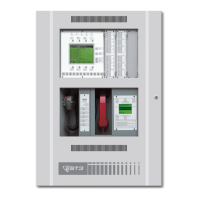Service and troubleshooting
8.72 EST3 Installation and Service Manual
Table 8-40: Addressable analog diagnostic table interpretation
Table Name Description Possible causes
Compatibility Fault Incorrect brand of device
installed, replace device.
SIGA, GSX, or XLS brand devices
intermixed on circuit.
Problem solving hints
Addressing faults
Most addressing faults are quickly located because the wrong
address gives a clue as to the fault location. For example module
164 is duplicated while module 174 is missing. The device at
location 174 probably has its tens digit addressing switch off by
one position.
Duplicate device faults are harder to locate, e.g. the carpenter put
up a partition hiding sensor 53, then the electrician noticed it was
missing and spliced in a new base and now there are two sensors
at address 53.
To identify devices with duplicate addresses, remove one of the
suspected duplicate sensors. The duplicate fault should clear
within 30 seconds if the sensor removed is a duplicate.
Disconnect half of the circuit. Allow a minute or so for the
circuit to stabilize and the faults to report. Upload the “Ready
Communication” diagnostics table only. The remaining duplicate
sensor, 53, should still appear, as if it is physically connected
between the circuit controller and the wiring break.
Continue to
add or remove segments of the circuit in gradual increments
repeating the diagnostics upload until the physical location of the
problem detector is located.
Intermittent communication and wiring faults
EST3 counts of the number of communications and errors
associated with each device. You can use this information to
diagnose problems.
• A message counter tracks the number of communications
sent between each device and the 3-AADC1 controller.
• An error counter tracks the number of communications
failures occurring between each device and the 3-AADC1
controller
Both counts return to 0 each time the controller is restarted. You
can use these To help to isolate a problem, compare the number
of messages sent to a specific device to the number sent to a
neighboring device of the same type.
Devices are polled each time the system is started, and any time
an object reports its status as trouble or alarm. Polling frequency

